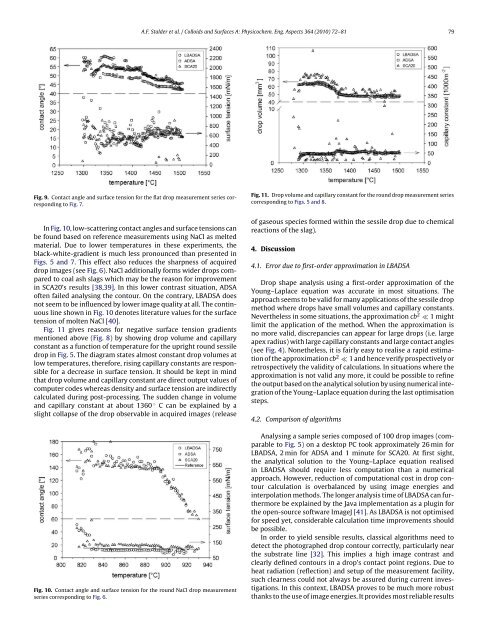Low-bond axisymmetric drop shape analysis for surface tension ...
Low-bond axisymmetric drop shape analysis for surface tension ...
Low-bond axisymmetric drop shape analysis for surface tension ...
You also want an ePaper? Increase the reach of your titles
YUMPU automatically turns print PDFs into web optimized ePapers that Google loves.
A.F. Stalder et al. / Colloids and Surfaces A: Physicochem. Eng. Aspects 364 (2010) 72–81 79<br />
Fig. 9. Contact angle and <strong>surface</strong> <strong>tension</strong> <strong>for</strong> the flat <strong>drop</strong> measurement series corresponding<br />
to Fig. 7.<br />
Fig. 11. Drop volume and capillary constant <strong>for</strong> the round <strong>drop</strong> measurement series<br />
corresponding to Figs. 5 and 8.<br />
In Fig. 10, low-scattering contact angles and <strong>surface</strong> <strong>tension</strong>s can<br />
be found based on reference measurements using NaCl as melted<br />
material. Due to lower temperatures in these experiments, the<br />
black-white-gradient is much less pronounced than presented in<br />
Figs. 5 and 7. This effect also reduces the sharpness of acquired<br />
<strong>drop</strong> images (see Fig. 6). NaCl additionally <strong>for</strong>ms wider <strong>drop</strong>s compared<br />
to coal ash slags which may be the reason <strong>for</strong> improvement<br />
in SCA20’s results [38,39]. In this lower contrast situation, ADSA<br />
often failed analysing the contour. On the contrary, LBADSA does<br />
not seem to be influenced by lower image quality at all. The continuous<br />
line shown in Fig. 10 denotes literature values <strong>for</strong> the <strong>surface</strong><br />
<strong>tension</strong> of molten NaCl [40].<br />
Fig. 11 gives reasons <strong>for</strong> negative <strong>surface</strong> <strong>tension</strong> gradients<br />
mentioned above (Fig. 8) by showing <strong>drop</strong> volume and capillary<br />
constant as a function of temperature <strong>for</strong> the upright round sessile<br />
<strong>drop</strong> in Fig. 5. The diagram states almost constant <strong>drop</strong> volumes at<br />
low temperatures, there<strong>for</strong>e, rising capillary constants are responsible<br />
<strong>for</strong> a decrease in <strong>surface</strong> <strong>tension</strong>. It should be kept in mind<br />
that <strong>drop</strong> volume and capillary constant are direct output values of<br />
computer codes whereas density and <strong>surface</strong> <strong>tension</strong> are indirectly<br />
calculated during post-processing. The sudden change in volume<br />
and capillary constant at about 1360 ◦ C can be explained by a<br />
slight collapse of the <strong>drop</strong> observable in acquired images (release<br />
Fig. 10. Contact angle and <strong>surface</strong> <strong>tension</strong> <strong>for</strong> the round NaCl <strong>drop</strong> measurement<br />
series corresponding to Fig. 6.<br />
of gaseous species <strong>for</strong>med within the sessile <strong>drop</strong> due to chemical<br />
reactions of the slag).<br />
4. Discussion<br />
4.1. Error due to first-order approximation in LBADSA<br />
Drop <strong>shape</strong> <strong>analysis</strong> using a first-order approximation of the<br />
Young–Laplace equation was accurate in most situations. The<br />
approach seems to be valid <strong>for</strong> many applications of the sessile <strong>drop</strong><br />
method where <strong>drop</strong>s have small volumes and capillary constants.<br />
Nevertheless in some situations, the approximation cb 2 ≪ 1 might<br />
limit the application of the method. When the approximation is<br />
no more valid, discrepancies can appear <strong>for</strong> large <strong>drop</strong>s (i.e. large<br />
apex radius) with large capillary constants and large contact angles<br />
(see Fig. 4). Nonetheless, it is fairly easy to realise a rapid estimation<br />
of the approximation cb 2 ≪ 1 and hence verify prospectively or<br />
retrospectively the validity of calculations. In situations where the<br />
approximation is not valid any more, it could be possible to refine<br />
the output based on the analytical solution by using numerical integration<br />
of the Young–Laplace equation during the last optimisation<br />
steps.<br />
4.2. Comparison of algorithms<br />
Analysing a sample series composed of 100 <strong>drop</strong> images (comparable<br />
to Fig. 5) on a desktop PC took approximately 26 min <strong>for</strong><br />
LBADSA, 2 min <strong>for</strong> ADSA and 1 minute <strong>for</strong> SCA20. At first sight,<br />
the analytical solution to the Young–Laplace equation realised<br />
in LBADSA should require less computation than a numerical<br />
approach. However, reduction of computational cost in <strong>drop</strong> contour<br />
calculation is overbalanced by using image energies and<br />
interpolation methods. The longer <strong>analysis</strong> time of LBADSA can furthermore<br />
be explained by the Java implementation as a plugin <strong>for</strong><br />
the open-source software ImageJ [41]. As LBADSA is not optimised<br />
<strong>for</strong> speed yet, considerable calculation time improvements should<br />
be possible.<br />
In order to yield sensible results, classical algorithms need to<br />
detect the photographed <strong>drop</strong> contour correctly, particularly near<br />
the substrate line [32]. This implies a high image contrast and<br />
clearly defined contours in a <strong>drop</strong>’s contact point regions. Due to<br />
heat radiation (reflection) and setup of the measurement facility,<br />
such clearness could not always be assured during current investigations.<br />
In this context, LBADSA proves to be much more robust<br />
thanks to the use of image energies. It provides most reliable results
















